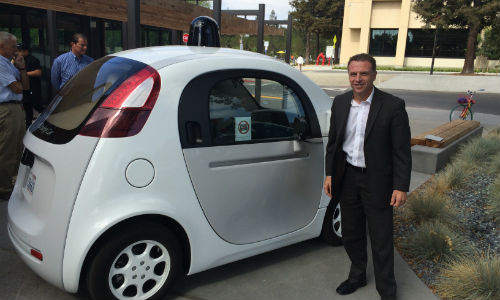By Dylan O’Hagan
Peterborough, Ontario — May 4, 2016 — Ontario’s Ministry of Transportation has taken steps to prepare for the introduction of autonomous vehicles (AVs), including a pilot program launched at the beginning of 2016. For more on this, please see “Legislative framework still needed for autonomous vehicles.“
However, at least organization would like to see a much more conservative approach to autonomous vehicles than Ontario’s AV pilot program. Driving decisions occasionally involve not just quick-thinking, but ethics. This has lead some people to insist that a human element should be a necessary requirement for AVs.
John M. Simpson is a representative of Consumer Watchdog, a US-based not-for-profit organization established in 1985. Simpson is a vocal critic of autonomous vehicles and has launched investigations of Google’s online privacy practices.
Consumer Watchdog has called on the US-based National Highway Traffic Safety Administration (NHTSA) to require all future AVs to include a steering wheel and other controls. During an interview with Collision Repair magazine, Simpson pointed to statistics released by Google in which the company’s AVs experienced failures 272 times in 14 months. The failures required human intervention 13 times. Simpson said he believes AV manufacturers like Google are rushing forward, and more questions should continue to be posed to any companies looking to work in the AV space.
Simpson is even hesitant about AV’s test driving on open roads, like Ontario’s pilot project. He agrees that testing is good and that more testing is better, but says he would prefer testing to be confined to a closed track first before being moving to roads. Simpson says he believes Canadian legislation should require a human to be inside the AV to take control.
“Canada’s regulations should put safety first, and making sure that someone capable of driving is in the vehicle,” he says.
Simpson added that data collected around AV crash statistics should also be made public so consumers can make properly informed choice in regards to safety of the AV.
“Autonomous vehicles are programmed to make ethical decisions. People should know if they will protect the people in the car as a priority or the people on the street,” he said. “It also can’t be some little black box. It has to be transparent so people know how the technology will make life and death decisions.”
Ontario’s pilot program does require a human to be in the driver’s seat at all times. They must monitor the operation of the AV and be capable of taking over control. The pilot program is regulated under the current Highway Traffic Act and no other regulations are required by the MTO at the moment. However, the pilot program will help to gather data needed to create future legislation surrounding safety and data security when AV’s are introduced on a grand scale, according to Bob Nichols, Senior Media Liaison Officer for Ontario’s Ministry of Transportation.
“The pilot program is focused on gathering data related to road safety and determining if future legislative and regulatory change may be needed to accommodate this new technology on-road in Ontario,” says Nichols. “The Province is reviewing data security and privacy considerations as they apply to the broader roll-out of automated vehicles and to develop the appropriate policy.”
Questions about insuring AVs are still in need of answers. Do traditional insurance models still hold, or will auto insurance be treated more as a case of product liability?
Mark Francis is the Manager of Driver and Vehicle Licensing for the Insurance Corporation of British Columbia (ICBC). He believes insurance premiums will drop for consumers as a result of AVs.
“As an insurance company, we are watching crash rates of vehicles that have the advanced crash avoidance,” says Francis. “All insurance companies are going to have to make sure that they are right pricing because as lost costs drop so should premiums. Certainly those (who are) price tracking will do better than those who aren’t so responsive. So, the insurance industry really needs to keep a close eye so companies can price their products properly, fairly and competitively. Products themselves will change as well because we’ll see manufacturers being liable for their technology.”
Francis says, as the technology advances, he expects AVs to become fully capable of driving without the need of human intervention at any point. However, he notes that laws may have to be made around switching between AV mode and manual control.
“We’ll probably want to change our laws as it relates to violations once operating a vehicle. The vehicle may be in autonomous mode or it may switch between the two,” said Francis. “We need to think about how we manage driving offenses in some degree.”
The most recent development around AV regulations is a study announced by the Canadian Senate Standing Committee on Transport and Communications. It was authorized by the Senate March 9, 2016, to study the regulatory and technical issues related to the deployment of connected and automated vehicles. In particular, the study will consider the long-term implications and challenges of these technologies, such as the impacts on privacy, energy, land use, transportation demand and employment. The committee will provide the report to the Senate by March 30, 2017.













































































